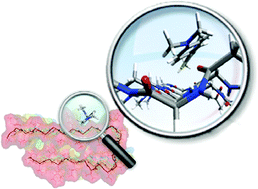Crystal structure of thioflavin-T and its binding to amyloid fibrils: insights at the molecular level†
Abstract
Combining X-ray data on

* Corresponding authors
a
Departament de Química, Universitat Autònoma de Barcelona, Barcelona, Spain
E-mail:
mariona.sodupe@uab.cat, pilar.gonzalez.duarte@uab.cat
b Dipartimento di Chimica IFM and NIS Centre of Excellence, Università degli Studi di Torino, 10125 Torino, Italy
c Servei de Difracció de Raigs X, Universitat Autònoma de Barcelona, Barcelona, Spain
d Fundación Pública Galega de Medicina Xenómica, CHUS, 15786 Santiago de Compostela, Spain
Combining X-ray data on

 Please wait while we load your content...
Something went wrong. Try again?
Please wait while we load your content...
Something went wrong. Try again?
C. Rodríguez-Rodríguez, A. Rimola, L. Rodríguez-Santiago, P. Ugliengo, Á. Álvarez-Larena, H. Gutiérrez-de-Terán, M. Sodupe and P. González-Duarte, Chem. Commun., 2010, 46, 1156 DOI: 10.1039/B912396B
To request permission to reproduce material from this article, please go to the Copyright Clearance Center request page.
If you are an author contributing to an RSC publication, you do not need to request permission provided correct acknowledgement is given.
If you are the author of this article, you do not need to request permission to reproduce figures and diagrams provided correct acknowledgement is given. If you want to reproduce the whole article in a third-party publication (excluding your thesis/dissertation for which permission is not required) please go to the Copyright Clearance Center request page.
Read more about how to correctly acknowledge RSC content.
 Fetching data from CrossRef.
Fetching data from CrossRef.
This may take some time to load.
Loading related content
